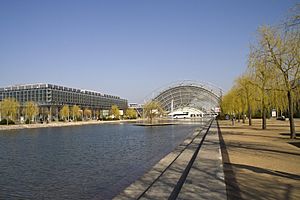Leipzig Trade Fair facts for kids
The Leipzig Trade Fair (called Leipziger Messe in German) is a very old and important place where businesses show off their products and ideas. It has been around for almost 1,000 years! After World War II, Leipzig was in East Germany. The fair became a key meeting spot for business people and politicians from both sides of the "Iron Curtain" (the imaginary line dividing East and West during the Cold War). Since 1996, the fair has been held at a new location about 7 kilometers north of the city center.
Contents
The Long History of Leipzig Fairs
How the Leipzig Fair Started
The story of the Leipzig fairs began a long, long time ago, in the Middle Ages. The first time a fair in Leipzig was mentioned was in the year 1165. A ruler named Otto the Rich, who was the Margrave of Meissen, gave special protection to the Leipzig fairs. This meant no other fair was allowed within about 7.5 kilometers of Leipzig.
Later, in 1268, another ruler, Theodoric of Landsberg, promised to protect all merchants traveling to Leipzig. He protected their lives and their goods, even if their own ruler was fighting with him. This made many merchants want to live in Leipzig. They traded things like herring, cloth, wine, and pepper.
Growing Bigger: 15th to 18th Centuries
Over time, Leipzig started having two big fairs each year. One was around Easter, and the other was in September. In 1458, Frederick II of Saxony gave permission for a third fair in Leipzig, called the New Year's Fair. German emperors later confirmed these three fairs, which helped the merchants in Leipzig become very successful.
In 1497, Emperor Maximilian I confirmed all three Leipzig fairs again. He also made a rule that no other fairs could be started in nearby areas. In 1507, he made this rule even stronger, banning any fairs within about 15 miles of Leipzig. This made Leipzig even more important as a marketplace. It also meant that other towns like Halle and Erfurt had fewer advantages for trade.
By the 18th century, Leipzig became a major center for trading goods from Russia, Poland, and England. People even called it 'the marketplace of all Europe'!
Modern Times and World Events
The fair's importance led to the building of many interesting places. In 1895, Leipzig held its first "sample fair." This was a new type of fair where exhibitors showed samples of their goods instead of selling everything right there. Between 1893 and 1938, many "fair-houses" were built in Leipzig's city center. These buildings often had shops, storage areas, and places to live. Leipzig became the main German fair for books and everyday items.
In 1920, a special area for technical fairs was opened in the southeast of the town. This area is now called Alte Messe Leipzig. During World War II, parts of this area were used for making military supplies and were damaged by bombs.
After the war, in 1946, the first "Peace fair" took place. When East Germany joined Comecon (a group of communist countries) in 1950, the fair became a place to show products from East Germany and its allies. It was also a rare place where people from Western countries could meet and trade with those from the East.
The Leipzig Trade Fair played a big role during the Cold War. It allowed people from countries like the United States and the United Kingdom to visit East Germany. This helped East Germany try to gain more recognition from Western governments. Even during tough times, like when the Berlin Wall was built in 1961, the fair was so important that some politicians called for a boycott to protest.
The Leipzig Fair Today
In 1996, a brand new trade fair ground was opened. The Congress Center Leipzig was also built there. The old fairground is now used for shops, events, supermarkets, and even ice skating.
Facts About the New Fairground
The new Leipzig Trade Fair was built between 1995 and 1996. It has six large halls. Five of these are exhibition halls, each about 20,000 square meters in size. It also has the world's largest glass hall, which seems to float! The fairground has about 14,000 parking spaces and is easy to reach by tram, train, bus, or car.
Who Runs the Leipzig Fair?
The company that runs the fair, Leipziger Messe GmbH, was started after Germany reunited in 1996. It is owned equally by the state of Saxony and the city of Leipzig. The company has about 400 employees.
The Leipzig Trade Fair also has several smaller companies that help it run:
- FAIRNET (which builds booths for exhibitors)
- Leipziger Messe Gastveranstaltungen (which organizes events)
- LMI Leipziger Messe International (which organizes international trade fairs)
- MaxicoM (which helps foreign companies come to Germany)
- fairgoumet (which provides food and drinks)
The company also has about 22 offices in other countries around the world.
|
Facts About the New Fairground
The new Leipzig Trade Fair was built between 1995 and 1996. It has six large halls. Five of these are exhibition halls, each about 20,000 square meters in size. The sixth hall is the world's largest glass hall that seems to float! It was designed by Ian Ritchie Architects. The fairground has about 14,000 parking spaces. You can get there easily by tram, train, bus, or car.
See also
 In Spanish: Feria de Leipzig para niños
In Spanish: Feria de Leipzig para niños




